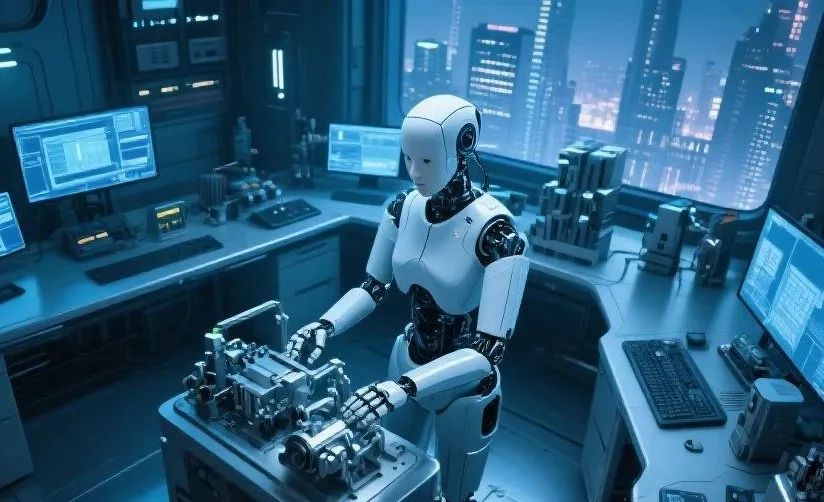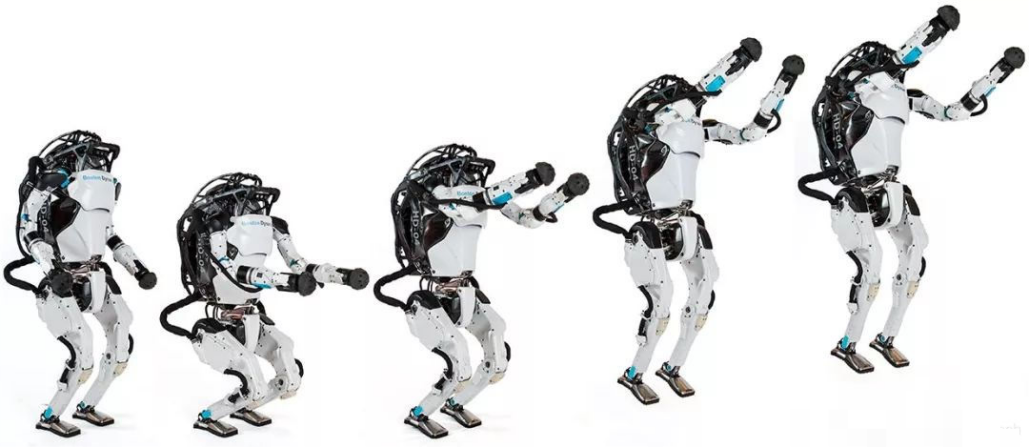Embodied Intelligence: Scaling Three Formidable Peaks
![]() 08/06 2025
08/06 2025
![]() 449
449

Original: Shenmou Finance and Economics (chutou0325)
Over the past decade, the tech industry has been no stranger to fleeting trends.
From VR glasses to virtual currency blockchain, and the metaverse, which of these concepts did not once spark optimism only to fizzle out eventually?
Therefore, when embodied intelligence suddenly gained popularity this year, many were skeptical: Here we go again?
01
Embodied Intelligence: A Successor to Many Trends
Indeed, embodied intelligence shares many traits with its predecessor trends.
Why is that so?
In addition to the iconic event of "robots dancing on the Spring Festival Gala," another significant milestone was its inclusion in the "Government Work Report" for the first time this year: "Establish a growth mechanism for future industry investment and cultivate future industries such as bio-manufacturing, quantum technology, embodied intelligence, and 6G."
Embodied intelligence has become a crucial direction for China's future industry cultivation and a "key area" of global technological competition and cooperation.
In just the first half of 2025, over 20 billion yuan poured in, with more than 130 financing events. Tech giants like OpenAI, NVIDIA, Google, Huawei, and Alibaba all entered the fray to compete for this "hot cake."
However, many voices of pessimism emerged.
For instance, Zhu Xiaohu, the founder of Jinshajiang Venture Capital, directly stated that the commercial path of embodied intelligence is unclear and withdrew from investing in humanoid robot companies in batches. Fu Sheng, CEO of Cheetah Mobile, also firmly believes that the landing of humanoid robots is too difficult and their applications are too distant, taking at least five years or even longer to materialize.
Even international investment banks noticed Unitree Robotics. After researching the company on February 27 following the Spring Festival, they issued a report stating that humanoid robots still have a long way to go before they can be truly put into production and daily use, and that market expectations for this technology may be overly optimistic.
It seems that embodied intelligence might follow in the footsteps of its predecessors, like virtual currency, blockchain, AR glasses, autonomous driving, and the metaverse, with realizations that remain distant.
02
Technology and Cost: A Double Bind
Economic Value Hard to Realize
These concerns are not unfounded.
First, technologically, there are bottlenecks such as computing power, battery capacity, and the balance between mental and physical capabilities.
The concept of embodied intelligence was first proposed as early as 1950. Whether it's the development of semiconductors or advances in programming technology, related startups have yet to produce anything usable.
It was only after the emergence of concepts like Industry 4.0 that the relevant industrial chain saw some development. But even in Isaac Gym, where 99% of algorithms have a success rate, when implemented on a real-world robotic arm, the task success rate can drop to 30%. Both domestic and foreign embodied intelligence AI generalization capabilities show obvious deficiencies, with task failure rates generally above 10% in unpreset scenarios (such as cluttered home environments).
However, most of these developments are concentrated in the fields of fixed robots, wheeled robots, quadruped robots, tracked robots, etc., and the work they can perform is simple and singular.
Until the advent of artificial intelligence.
The surface of artificial intelligence is algorithms, but its core is computing power, and large models are an upgraded form that combines them. It can be said that future embodied intelligence with more thinking capabilities will definitely be driven by large models.
However, this also brings about new challenges - the "brain capacity" of robots is too small to install a multi-modal large model with 100 billion parameters.
Due to the complex and variable working scenarios of robots, the option of "cloud services" with high latency and instability is almost eliminated. Therefore, robots also need to consider the bottlenecks of battery technology itself. When the battery capacity carried by the robot is limited, how to balance high power consumption with high "brainpower"? This problem has been solved by humans through millions of years of evolution, but the time given for robots to evolve will obviously not be too long.
Secondly, the high cost of embodied robots leads to a tug-of-war between capital and cash flow.
Taking industry pioneer "Boston Dynamics" as an example, it swept the competition in the field of quadruped robots but changed hands three times in the past decade, from Google to SoftBank to Hyundai. The reason for each change of ownership is evident in the financial report deficit: the cost of an Atlas experimental machine is $2 million - equivalent to a luxury home on Beijing's Third Ring Road, but it can only run obstacle courses and is afraid to even hand over a cup of coffee for fear of spilling it.
Domestic embodied intelligence companies share this sentiment.
Zhiyuan Robotics hastily submitted its prospectus just two years after its establishment due to dwindling cash flow. In 2023, Zhiyuan Robotics lost 870 million yuan, and the cash on its books was only enough to sustain operations for another 18 months. If it did not go public to "replenish its blood," it would have to list its laboratory robotic arms on second-hand platforms.
Similarly, the revenue of CloudMinds Technology, a leading service robot company, increased from 161 million yuan in 2022 to 245 million yuan in 2024, with a compound annual growth rate of 23.2%. However, the losses during the same period were as high as 365 million, 264 million, and 185 million yuan, respectively. Geek+, the leading mobile robot company closely related to embodied intelligence, suffered even greater losses, with revenue of 2.409 billion yuan in 2024 but a loss of 832 million yuan. It stated frankly in its prospectus: "We prioritize business expansion and innovation, focusing on long-term value creation rather than short-term financial returns."
Setting aside training and labor costs, the hard expenditures alone are astronomical.
For example, the three major hardware components - reducers, servo motors, and controllers - account for 60-70% of the total machine cost. For every 0.01mm increase in precision, another zero needs to be added to the budget.
Algorithms are not cheap either. Huawei Cloud once calculated that running a large model with 1 billion parameters on a robot would require 10,000 A100 graphics cards working non-stop for a month, resulting in an exorbitant electricity bill.
Moreover, the scenarios for embodied robots are extremely limited, and they are difficult to compete with humans in terms of both working prices and flexibility.
Many may have envisioned scenes from science fiction movies or games where robots can think and work like humans. However, in reality, embodied intelligence will struggle to meet such expectations for one or two decades or even longer.
Currently, almost no robot company ever compares their robots with humans in public. After all, in terms of "working," embodied robots are also typical examples of "not good enough for high-end tasks and too expensive for low-end tasks."
Each G1 robot from Unitree Technology requires manual adjustment of joint motors, with a monthly production capacity of only 300 units. The hardware gross margin of Boston Dynamics' Atlas is only 18%, losing half the cost of selling one. It almost turns high-tech into "charity."

(Boston Dynamics Atlas Robot)
Robots produced by Zhiyuan Robotics account for 70% of industrial scenarios, but once they return to the family living room, the price tag of nearly 100,000 yuan immediately dissuades all potential buyers - after all, with the same budget, one can hire a real human nanny for three years and receive comprehensive care.
In essence, they can do too little work and are too expensive. They cannot compete with humans in terms of service quality and price, nor are they as convenient and easy to use as AI large models. There may be an inappropriate metaphor - when the cost of using slaves is much lower than that of machines, southern farmers will not embrace industry.
Therefore, when costs and revenue do not match, an "internet bubble-like" loss phenomenon emerges - in 2024, the average gross margin of Chinese humanoid robot companies was only 18%, and UBTECH's cumulative losses from 2020 to the first half of 2024 amounted to a staggering 4.3 billion yuan.
03
Where is the Breakthrough?
However, compared to its "predecessors," embodied intelligence is an "anomaly."
Upon closer inspection, you will find that the essential reasons why those "predecessors" cooled down are: concept first, technology lagging, and low practical value.
Taking VR glasses as an example, brands such as PICO and iQIYI VR have encountered obstacles one after another.
The main reason is that various core components are monopolized by a few suppliers, leading to a lack of motivation for development and iteration, coupled with high prices, making them into "toys for the rich." When the number of users is limited, the developer's payback period is long, and there is little high-quality content. Users are "excited before buying but neglect it after buying," eventually forming a vicious cycle of "low output - low purchase - low income."
Coupled with the 500+ gram weight and the experience of heating up in half an hour, VR is destined to stay within the small circle of hardcore gamers.
Similarly, the imagination of the metaverse, although grand, cannot escape the three major obstacles of computing power, content, and terminals.
As a result, after the initial excitement, only the concept remains.
However, although embodied intelligence also bears the aura of "science fiction," the mountains in front of it can be climbed.
Technologically, the rise of embodied intelligence has always been in resonance with the iteration of AI large models - the evolution speed of this "intelligent brain" is driving the embodied intelligence industry forward with unprecedented force.
For example, the "Huisi Kaiwu" platform of BAAI attempts to solve the problem: using AI large models to drive the "brain" to plan tasks and data to drive the "cerebellum" to control limbs, achieving unified control across robotic arms and humanoid robots for the first time.
Another example is the cooperation between GAC Group and Huawei Cloud. Through the multi-modal capabilities of Pangu, it can restore 2D video and 3D point cloud data of complex driving scenarios within minutes, shortening the end-to-end model iteration cycle to "one version every two days."
Too expensive hardware? Companies immediately change their plans - reducers, drives, sensors, whichever is expensive is replaced, and domestic alternatives can immediately meet the demand.
The Panasonic HG-C laser displacement sensor costs at least 1500 yuan, while the domestic Hongchuan Technology HC6 achieves a measuring range of 800mm and a sampling rate of 2000Hz, with a maximum price of only 899 yuan.
To incentivize research on embodied intelligence, the Guangming District of Shenzhen directly announced that starting from 2025, it will provide rewards of up to 20 million yuan to newly established national top 100 software enterprises, national top 100 internet enterprises, and national top 100 AI comprehensive strength enterprises; and rewards of up to 10 million yuan to newly established "key software enterprises encouraged by the state."
Slow scenario landing? On the one hand, companies comply with the market, such as UBTECH's Walker being deployed in the education industry, with 60% of its revenue coming from AI interest classes in primary and secondary schools; Unitree's G1 robots directly secured 500 orders from BYD in 2024, simply because their price is one order of magnitude lower than that of imported products.
On the other hand, major companies have begun to develop specialized large models for embodied intelligence, such as Figure AI's Helix, which achieves a cross-scenario task success rate exceeding 90%.

(Educational Robot)
More critically, China's unique industrial cluster advantage has paved a golden path for embodied intelligence to move from the laboratory to the production line.
In the Guangming Science City of Shenzhen, UBTECH's super factory, DJI's innovation center, and Huawei's HarmonyOS laboratory are gathered, forming a 15-minute ecosystem of "research and development - testing - mass production." The patent density of robot enterprises is as high as 1200 items per square kilometer, three times that of similar parks in Silicon Valley.
In the Yangtze River Delta, a 3-hour drive covers core suppliers such as Suzhou Green Harmonic reducers and Ningbo Zhongdalide servo motors; the Zhijiang Laboratory in Shanghai and Hangzhou jointly established the "Human-Machine Collaboration Joint Laboratory," processing 100 million pieces of multi-modal interaction data every day. In addition, more than 10,000 robot patents in the Yangtze River Delta are shared for free, saving Jieka Robotics 30% of its R&D costs, which can be fully invested in the next iteration.
The special feature of embodied intelligence is that it requires both hardware breakthroughs similar to VR and relies on software revolutions like large models. Its future is not determined by concepts but by the speed of technological iteration - with each generation of large model upgrades, the "brainpower" of robots undergoes a leap; and with each replacement of domestic components, costs are reduced.
Recall our previous summation of DJI's success: It thrives due to its strategic location in the Pearl River Delta region. This locale facilitates rapid part testing and replacement, resulting in swift iteration and minimal trial-and-error costs. Foreign companies, on the other hand, often face a three-to-five-fold longer process for developing consumer electronics, encompassing customization, testing, and component selection.
When the entire industrial chain, from upstream to downstream, is autonomously controlled, China's robust industrial foundation serves as the cornerstone of embodied intelligence. This foundation enables the swift transformation of abstract concepts into tangible productivity revolutions that reshape the physical world.
* Images sourced from the internet. Should any infringement occur, please contact us for prompt removal.








